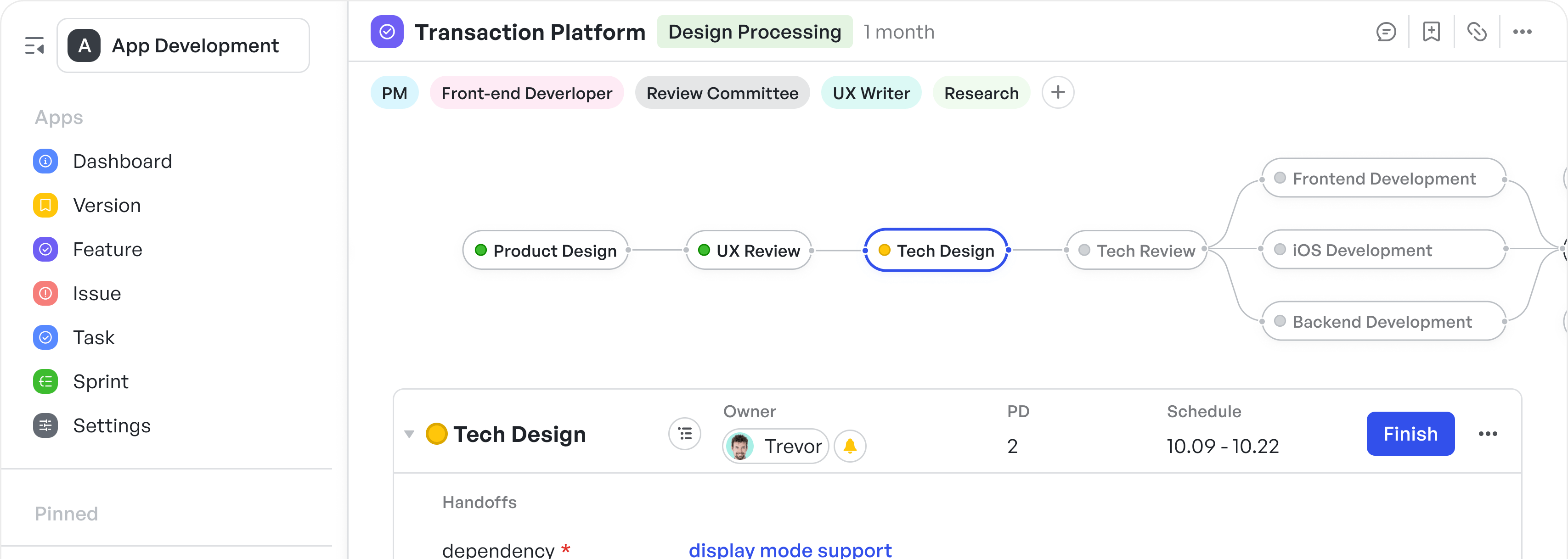Software development project management is one of the toughest challenges out there. With ever-changing technologies and teams from different backgrounds, it feels like summiting Mt. Everest in unpredictable weather. Every step pushes your limits and tests your ability to keep everything on track.
Software development project management connects teams, tools, and timelines to deliver high-quality outcomes. Whether you're a product manager or project manager, mastering this skill is essential in 2025.
Efficient project management for software development ensures every phase (from planning to delivery) stays on track.
This guide unpacks the process, offering practical steps to streamline workflows and achieve project success efficiently.
What is software development project management?
Software development project management involves planning and structuring software development to meet specified objectives, ensuring the alignment of resources, timelines, and deliverables to complete a project successfully.
Unlike traditional project management, managing a software development project requires navigating evolving requirements, regular testing, and adapting to rapidly shifting technologies. Project managers play a pivotal role in coordinating cross-functional teams—developers, designers, testers, and stakeholders—fostering collaboration and alignment at every stage of the software lifecycle.
Using project management tools, managers can monitor progress through real-time updates, enhancing visibility into iterative development cycles. These tools facilitate collaboration across teams, ensuring tasks align with dynamic project requirements and evolving priorities.
At its core, software development project management revolves around balancing technical precision with adaptability. It emphasizes managing iterative processes like sprint planning, continuous testing, and feature releases, all while maintaining team efficiency and meeting stakeholder expectations.
This approach ensures productivity is sustained, and technical deliverables meet the required quality standards.
Why is software development project management critical?
Software development project management brings order to otherwise chaotic, rapid, and often unpredictable development processes. Teams will always remain focused on goals, and the project will be completed on time.
Effective project management for software development minimizes risks and optimizes resource allocation, avoiding delays and managing unforeseen challenges.
Using proper strategies, managers can strengthen project deliverables, mark milestones, and improve collaborative efforts. This further drives seamless teamwork among various departments, from developers to testers.
With software development project management tools, teams can monitor delivery speed and resource utilization, and identify data-backed scope of improvement of data.
Ultimately, software development project management supports project success by aligning team efforts with stakeholder expectations and ensuring that every project phase – from initial planning to post-launch updates, runs smoothly.
Roles & responsibilities of a software development project manager
The biggest responsibility that a software development project manager holds is guiding a project from concept to completion. They oversee the development project, ensuring teams meet deadlines and achieve objectives.
- Project planning and scope definition
- Project planning and scope definition
250px|700px|reset
加载中,请稍后
Planning a complete project roadmap
Project managers collaborate with product owners, developers, and stakeholders to outline user stories, technical specifications, and functional requirements. They prioritize tasks using backlogs and define milestones to track incremental progress.
Incorporating Agile methodologies or Scrum frameworks during planning offers flexibility and adaptability to changing requirements. Project management tools like Meegle help visualize the project roadmap and create sprint boards, keeping all contributors focused on immediate deliverables.
- Team management and communication
- Team management and communication
250px|700px|reset
加载中,请稍后
Manage the team with Meegle
Clear communication is key to effectively managing team member. Managers delegate tasks, address challenges, and ensure seamless collaboration within the software development team through structured communication practices.
Daily stand-up meetings act as quick check-ins where team members share progress, discuss roadblocks, and align priorities for the day. Sprint reviews allow the team to present completed work to stakeholders, gathering critical feedback to refine and adapt the project direction. Retrospectives, held at the end of each sprint, offer a space for honest reflection, enabling teams to identify successes, resolve pain points, and implement actionable improvements.
These practices, combined with collaborative tools like real-time dashboards and shared boards, create a transparent environment where everyone stays informed and connected, ensuring the project moves forward smoothly.
- Project execution and monitoring
- Project execution and monitoring
250px|700px|reset
加载中,请稍后
Monitor your project with Meegle
During execution, managers closely monitor feature development, code updates, and bug fixes to ensure the project is progressing as planned. They use tools like burn-down charts to track sprint progress and progress reports to measure the team's velocity, ensuring they stay on target.
With CI/CD (Continuous Integration/Continuous Deployment) pipelines, managers automate the building, testing, and deployment processes, allowing developers to focus on coding rather than manual tasks.
This not only speeds up the development cycle but also helps catch errors early, reducing the chances of bugs slipping into the final product. These practices allow the team to work efficiently, identify potential delays, and keep the project moving forward smoothly without compromising on quality.
- Quality assurance and stakeholder management
- Quality assurance and stakeholder management
250px|700px|reset
加载中,请稍后
Assigning tasks to stakeholders
Delivering high-quality software requires strong QA processes, and managers play a key role in ensuring these processes are in place.
They work closely with QA engineers to implement both automated testing and manual testing, including unit, integration, and regression tests. Continuous testing and deployment pipelines help detect and fix issues early, keeping development on track.
Managers also maintain clear communication with stakeholders, providing regular updates through demo presentations and progress reviews. The agile feedback cycle ensures that stakeholder expectations are continually assessed and met, allowing for quick adjustments and ensuring the final product aligns with their needs.
- Project documentation and closure
- Project documentation and closure
A key responsibility is creating detailed project documentation that goes beyond basic project plans, including API documentation, architecture diagrams, and user manuals.
This process captures valuable lessons learned, key takeaways from retrospectives, and best practices to improve workflows and avoid repeating mistakes in future projects. During the closing phase, project managers also conduct knowledge transfer sessions to ensure a smooth handoff, along with delivering maintenance guides that help sustain the software post-launch.
Efficient software development project management relies on these roles to ensure not only successful project completion but also long-term collaboration and continuous improvement across teams.
The 6 phases of the software development project lifecycle
Every software development project follows a structured life cycle comprising 6 phases. Each phase is critical to ensuring project success and involves specific activities to streamline the process.
- Initiation
- Initiation
The initiation phase applies the foundation for the project by defining its purpose and feasibility. Managers develop a project charter that outlines the objectives, scope, and stakeholders involved. This phase ensures alignment among all parties before moving forward.
Key activities:
- Identify key stakeholders, including project team members and decision-makers.
- Define the project scope.
- Conduct a feasibility study to assess technical and financial viability.
- Develop a project charter that includes objectives, timelines, and budgets.
- Secure approvals from senior leadership or stakeholders.
- Planning
- Planning
In this phase, detailed plans are created to guide the software development team. Managers break down tasks, assign roles, and select tools to manage the project timeline and resources efficiently.
Key activities:
- Create a detailed work breakdown structure (WBS) with milestones and deadlines.
- Allocate resources, including team members, budget, and tools.
- Establish communication protocols for regular updates and status reports.
- Use project management tools to set up dashboards and tracking mechanisms.
- Designing
- Designing
This phase focuses on translating project requirements into technical blueprints. The design serves as the roadmap for the development phase, confirming the final product aligns with user needs and expectations.
Key activities:
- Develop wireframes, mockups, or prototypes to visualize the product.
- Finalize the system architecture and define technical aspects (e.g., database design, APIs).
- Collaborate with stakeholders to gather feedback and approve designs.
- Document design specifications for the development team.
- Development
- Development
The development phase is where the actual product is built. The software development team works on coding, integrating, and testing features iteratively, often following agile methodologies for flexibility and efficiency.
Key activities:
- Assign specific tasks to developers based on the design documentation.
- Use code hosting and DevOps tools to facilitate version control and integration.
- Conduct peer reviews and unit tests to ensure each module works as intended.
- Regularly inform stakeholders on project progress and any challenges faced.
- Testing
- Testing
Testing ensures the product is bug-free, meets quality standards, and satisfies user expectations. Rigorous testing at this stage prevents costly issues after deployment.
Key activities:
- Conduct functional, integration, and performance testing to validate the software.
- Perform security tests to safeguard against vulnerabilities.
- Carry out user acceptance testing (UAT) with stakeholders to ensure the product aligns with requirements.
- Document bugs and collaborate with the development team to fix issues.
- Implementation
- Implementation
The final phase involves deploying the software into a production environment and ensuring a seamless transition. Post-deployment support is also part of this phase to address initial challenges and optimize performance.
Key activities:
- Deploy software to live environments, ensuring minimal disruption.
- Train users and provide comprehensive documentation for ongoing use.
- Monitor the software’s performance and collect user feedback.
- Address any post-launch issues promptly and schedule updates as needed.
Understanding these phases is vital for effective software development project management. Each phase depends on the previous one, providing a streamlined workflow and high-quality output.
Best tools for software development project management
Efficient software development project management relies heavily on the right tools. These tools help streamline workflows, enhance collaboration, and track project progress effectively.
Following are the best tools to manage every phase of a development project:
250px|700px|reset
加载中,请稍后
Meegle - project management tool of the next-gen
Meegle is designed to simplify workflows, enabling seamless planning, execution, and end-to-end monitoring of software development projects. It focuses on eliminating redundancy, streamlining communication, and providing the tools developers and project managers need to deliver high-quality software faster.
Meegle's key features
- Code-smart workflow: Meegle integrates seamlessly with GitHub and GitLab, syncing branches and committing project tasks. This integration automates repetitive work and ensures alignment between code and project requirements, allowing teams to stay focused on what matters most, building great software.
- Real-time dashboards: With visual workflows and real-time updates, managers get full visibility into the project timeline. Track milestones, identify bottlenecks, and keep progress moving with ease.
- Bug management for quality assurance: Meegle helps teams manage bugs efficiently. By tying issues to specific features, developers can track bug counts, repair rates, and analyze data to ensure high-quality releases. Continuous testing is facilitated through Meegle's agile feedback loops, ensuring software quality stays high throughout the development lifecycle.
- Prioritized task management: Large projects can easily become overwhelming. Meegle’s custom views help prioritize tasks, focusing teams on high-impact work while preventing important details from slipping through the cracks. This feature is particularly valuable when adapting to changes in scope or requirements.
- Seamless collaboration: Meegle's documentation features, from PRDs to review notes, keep everything organized and visible. Teams can see the status, responsibilities, and deadlines at a glance, enabling clearer communication and collaboration across functions.
Meegle’s solutions enable software teams to move past traditional project management hurdles, ensuring clear collaboration, streamlined workflows, and efficient delivery—at scale.
- Jira
- Jira
250px|700px|reset
加载中,请稍后
Jira (Source: PPM express)
Jira is a tool for agile project management. It’s used for tracking tasks, managing backlogs, and monitoring sprints.
Jira's key features
- Customizable workflows: Create workflows suited to your software development team.
- Integration with development tools: Seamlessly integrates with tools like Bitbucket, GitHub, Confluence, and CI/CD pipelines, streamlining development workflows from planning to deployment.
- Sprint management: Organize sprints efficiently with detailed tracking features.
- Advanced reporting: Generate in-depth reports on delivery speed and key performance indicators.
- Collaboration tools: Keep team members on the same page with shared boards and updates.
250px|700px|reset
加载中,请稍后
Asana (Source: Tallyfy)
Asana helps in managing complex software development projects with its user-friendly interface and task management capabilities.
Asana's key features
- Task assignments: Assign roles and track responsibilities at a granular level.
- Timeline view: Visualize the entire project lifecycle and adjust plans easily.
- Dependency management: Highlight task dependencies to avoid delays.
- Cross-functional collaboration: Align developers, designers, and product managers through shared boards and real-time updates.
- Automation: Simplify repetitive tasks to save time and boost productivity.
250px|700px|reset
加载中,请稍后
Teamwork (Source: Teamwork)
Teamwork is a tool designed to manage multiple projects and improve communication among teams and stakeholders.
Teamwork's key features
- Milestone tracking: Monitor significant achievements throughout the development phase.
- Time tracking: Keep track of resources and ensure the project budget is on target.
- Client collaboration: Share updates and insights with stakeholders effortlessly.
- Templates: Use templates, like bug tracking and product launch, to set up and streamline recurring projects.
Choosing the right tool depends on your team’s specific needs.
Key benefits of software development project management tools
The right project management software can transform how teams handle software development projects. The advantages they present include:
- Improved collaboration: Keep all team members aligned with centralized communication and real-time updates.
- Enhanced visibility: Offer a clear view of the project timeline, progress, and potential bottlenecks.
- Efficient resource allocation: Optimize time, budget, and personnel for maximum productivity.
- Streamlined workflows: Automate repetitive tasks and ensure a smooth project execution process.
- Better risk management: Identify and address potential risks early to prevent delays or setbacks.
- Informed decision-making: Use data-driven insights and key performance indicators for innovative planning and adjustments.
- Scalability: Manage multiple projects and adapt tools to growing team needs.
- On-time delivery: Track tasks and milestones to ensure timely and successful project completion.
Software development project management tools equip teams to focus on meaningful work, reducing complexity and driving efficient, high-quality outcomes.
Challenges that impact software development project management
Managing software development projects has unique challenges that can disrupt timelines and productivity. Addressing these is key to ensuring project success. Here are three significant obstacles plaguing the field today:
- Scope creep
- Scope creep
Uncontrolled changes or continuous additions to the project scope often derail timelines and inflate budgets.
Poorly defined requirements and inadequate change management processes are major contributors to this issue. Teams must set clear boundaries and use tools to monitor scope changes.
- Communication breakdowns
- Communication breakdowns
Miscommunication among team members, stakeholders, and cross-functional teams can lead to delays and misunderstandings.
Geographically dispersed teams, time zone differences, and a lack of standardized communication channels exacerbate this problem. Centralized communication tools and regular updates can mitigate these issues.
- Adapting to evolving requirements
- Adapting to evolving requirements
The tech industry's dynamic nature often requires teams to pivot mid-project. Without agile project management methodologies, adapting to changing requirements becomes cumbersome.
- Lack of managerial expertise in technical roles
- Lack of managerial expertise in technical roles
Many project managers come from technical backgrounds, bringing strong technical skills but lacking management expertise. This can lead to slow progress updates, miscommunication, and unclear task ownership. Information gaps between teams result in stakeholders being unaware of key developments, causing disjointed workflows.
Additionally, without a proper retrospective phase, recurring risks and mistakes can go unaddressed.
Tackling these challenges with modern tools and best practices ensures smoother workflows and better outcomes for software development projects.
Tips and best practices for software development project managers
To enhance software development project management, project managers can focus on these five actionable tips:
- Establish clear project goals and scope
- Establish clear project goals and scope
Begin by defining specific project requirements and aligning them with business objectives. A well-defined scope reduces the risk of scope creep and creates a unified vision for all stakeholders.
- Utilize robust project management tools
- Utilize robust project management tools
Adopt reliable project management tools like Meegle to streamline task assignments, monitor timelines, and foster team collaboration.
- Implement agile methodologies
- Implement agile methodologies
Embrace agile project management practices to handle changing requirements with ease. Iterative cycles improve adaptability and maintain momentum.
- Optimize resource allocation
- Optimize resource allocation
Delegate tasks based on skill sets and availability. This ensures balanced workloads, better productivity, and minimized delays.
- Communicate effectively
- Communicate effectively
Regular updates, clear channels, and transparent communication foster collaboration among team members and stakeholders, keeping everyone aligned.
Applying these best practices enhances efficiency and leads to consistent, high-quality project outcomes, keeping teams productive and aligned throughout the development process.
How Meegle streamlines software development
Meegle simplifies software development by offering a unified platform that enhances collaboration and streamlines workflows throughout the entire project lifecycle.
- Visual workflows & real-time dashboards: Meegle makes it easy to stay aligned with visual workflows that map out each phase of development. Real-time dashboards provide instant progress updates, identify potential roadblocks, and help teams stay on track.
- Agile flexibility: With agile tools built in, Meegle lets teams quickly adapt to changing requirements, ensuring smooth, continuous delivery without compromising on deadlines or quality.
- Automate collaboration: Meegle reduces manual work by automating tasks and integrating with tools like GitLab, keeping all workflows aligned and eliminating errors, ultimately saving time and improving productivity.
- Proactive risk management: Meegle’s data-driven insights allow teams to identify risks early, giving project managers the foresight to adjust processes and keep the project on track for successful, high-quality delivery.
By seamlessly integrating tools, optimizing workflows, and ensuring real-time visibility, Meegle empowers teams to deliver software projects faster, with fewer errors, and within scope.
Simplify your software development projects with Meegle
Managing software development projects doesn’t have to be complicated. Meegle’s intuitive features streamline the process, helping teams stay aligned, boost productivity, and ensure quality.
From planning to testing, Meegle supports each phase, allowing you to manage software projects efficiently.
Start optimizing your development process today. Try for free and discover how its features can transform your software project management experience.
FAQs
How can we manage software development projects?
Managing software development projects involves defining clear goals, planning tasks, allocating resources, and monitoring progress. Project management tools like Meegle, adopting agile methodologies, and maintaining effective communication are crucial to success.
What’s an example of software development project management?
An example could be developing a new mobile app. This involves defining the project scope, gathering requirements, assigning tasks to the development team, testing the product for quality assurance, and delivering the final product within the set timeline.
How does software project management differ from software development project management?
While software project management focuses broadly on managing any software-related project, software development project management deals explicitly with the software development process, including the coding, testing, and implementation phases, which are tailored to creating functional software products.





